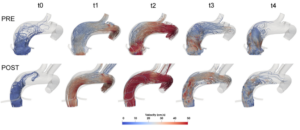Transcatheter aortic root repair (TARR) consists of the simultaneous endovascular replacement of the aortic valve, the root, and the proximal ascending aorta. Our CompMech Group members Anna Ferrarini, Dr. Rodrigo Romarowski, Prof. Michele Conti and Prof. Ferdinando Auricchio, in collaboration with the Cardiac Surgery Unit of the Cardiocentro Ticino, the University of Zurich (Prof. E. Ferrari) and the Cardiovascular Research Unit of the University of Lausanne (Prof. L. K. von Segesser), are studying a computational model of TARR in order to explore the impact of the endovascular procedure on the coronary circulation. To this aim, a patient-specific model of an aneurysmatic ascending aorta including the coronary ostia was derived from computed tomography angiography. Computational Fluid Dynamics simulations were run in both pre- and post-procedural configurations using a pulsatile inflow and lumped parameter models at the outflows to simulate peripheral aortic and coronary circulation.
After the virtual implant of TARR device with coronary grafts, flow became more organized and less recirculation was seen in the ascending aorta (see Figure 1). Coronary perfusion was guaranteed with negligible flow differences between pre- and post-procedural configurations. However, despite being well perfused by chimney grafts, the procedure induces an increase of the pressure drop between the coronary ostia and the ascending aorta of 8mmHg. The proposed numerical simulations suggest that the TARR technique maintains coronary perfusion through the chimney grafts.
October 21st, 2020


